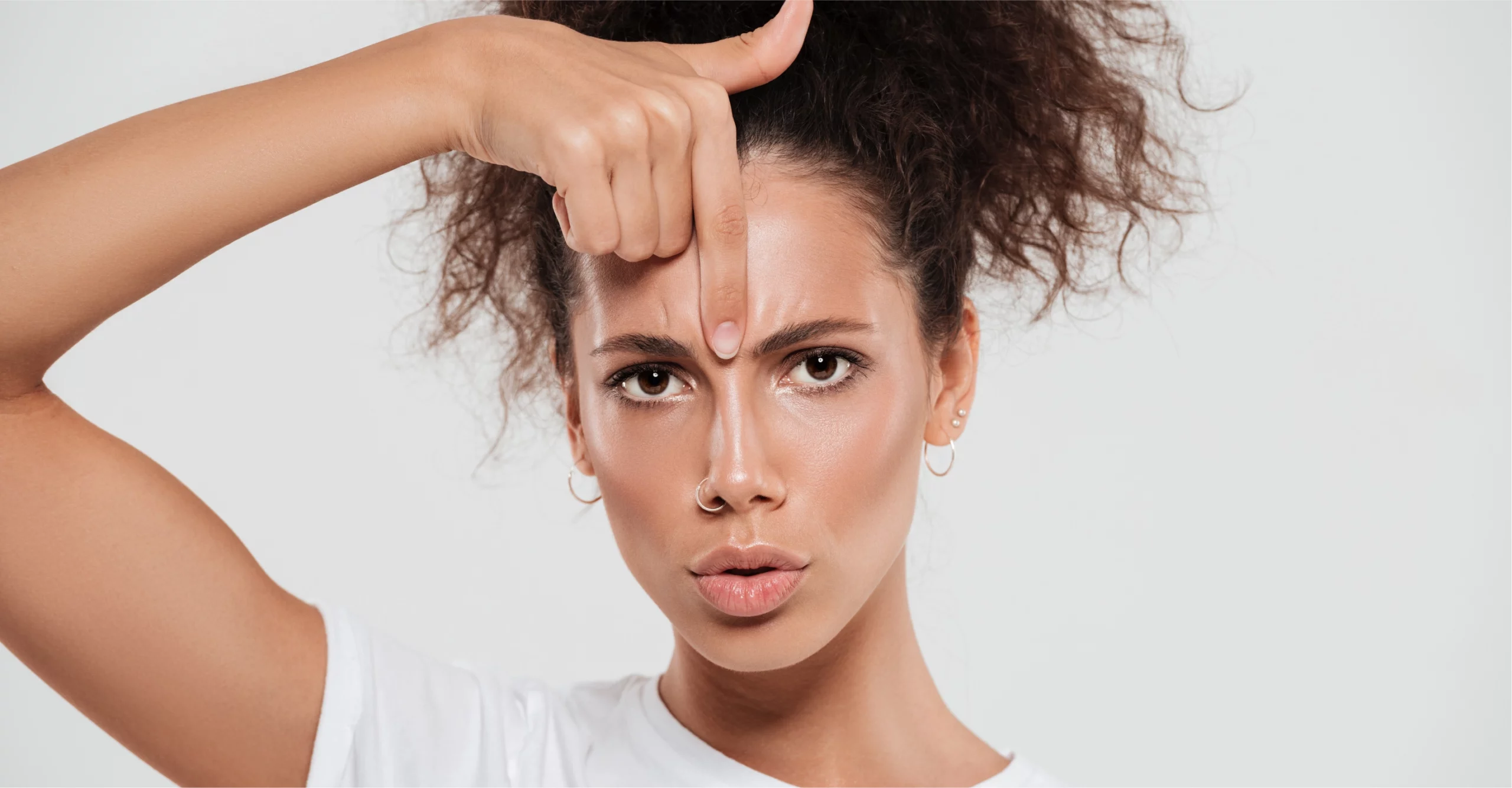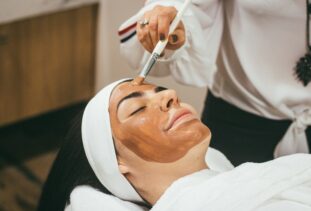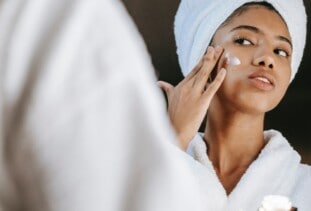With age comes wisdom, new outlooks on life, and…forehead wrinkles. Just when you think you’ve locked down your skin care routine, the sudden appearance of “11s” and worry lines have you running to your esthetician yet again.
Developing forehead lines is a natural part of aging — but that doesn’t mean there aren’t ways to slow down the process. Check out these 17 expert-backed tips to prevent and reduce forehead wrinkles.
Disclaimer: These skin care tips should not be interpreted as medical advice. Please seek a certified esthetician or dermatologist to learn which anti-aging procedure is right for you.
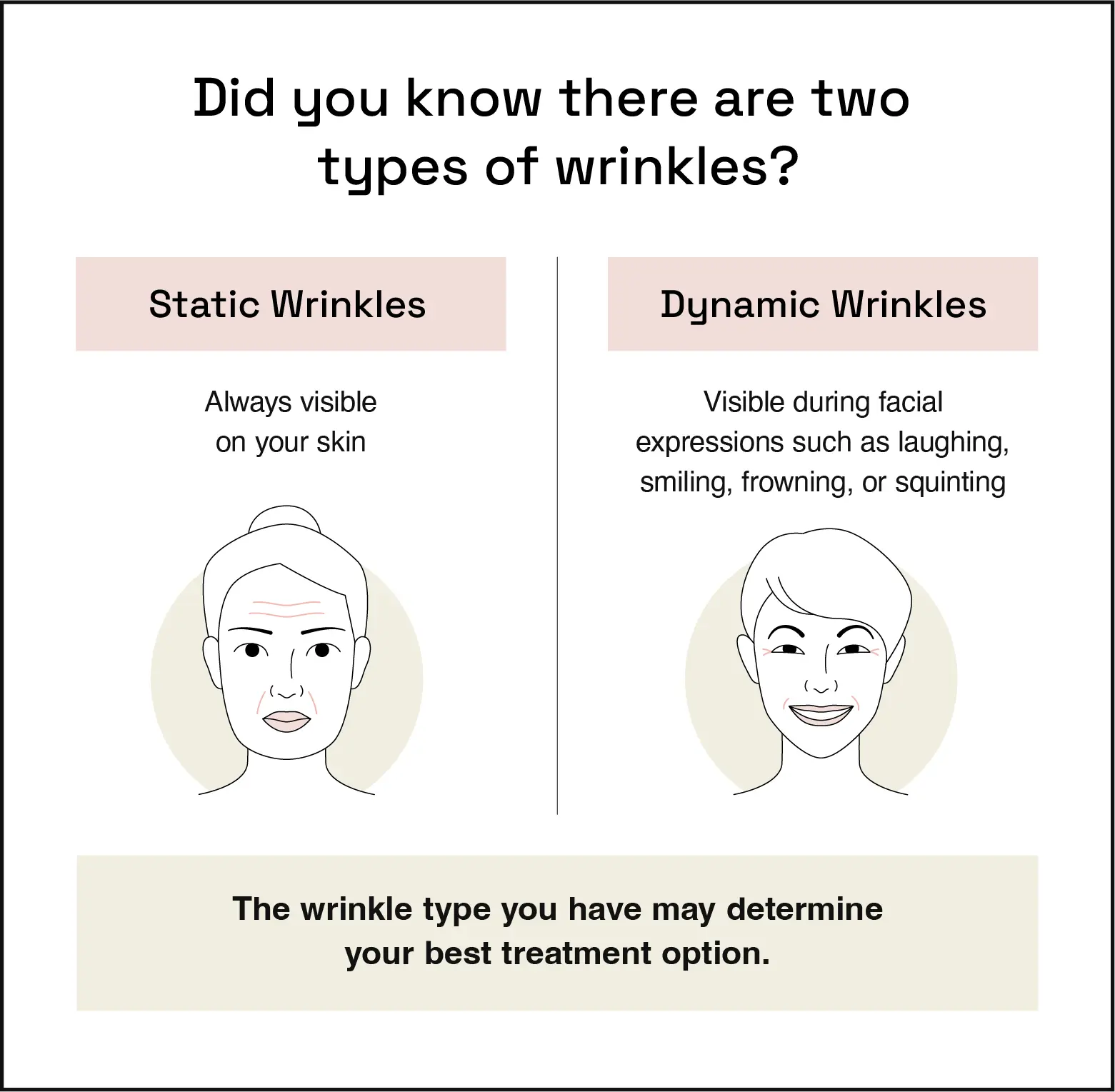
1. Drink plenty of water
Staying hydrated is essential for almost every bodily function — including keeping your skin healthy from the inside out. In addition to using quality moisturizing facial products, drinking the recommended amount of water per day (about 2.7 liters for women and 3.7 liters for men) can help prolong the appearance of youthful, vibrant skin.
However, it’s important to note that increasing your water intake is not a quick fix for reducing forehead wrinkles that have already taken form, also known as static wrinkles. As we age, our skin becomes thinner — and contrary to popular belief, no amount of water can reverse this.
If you’re just beginning to notice signs of aging, staying hydrated can delay the inevitable. Regardless, you should strive to hit your daily water goal for clearer, brighter skin no matter your age.
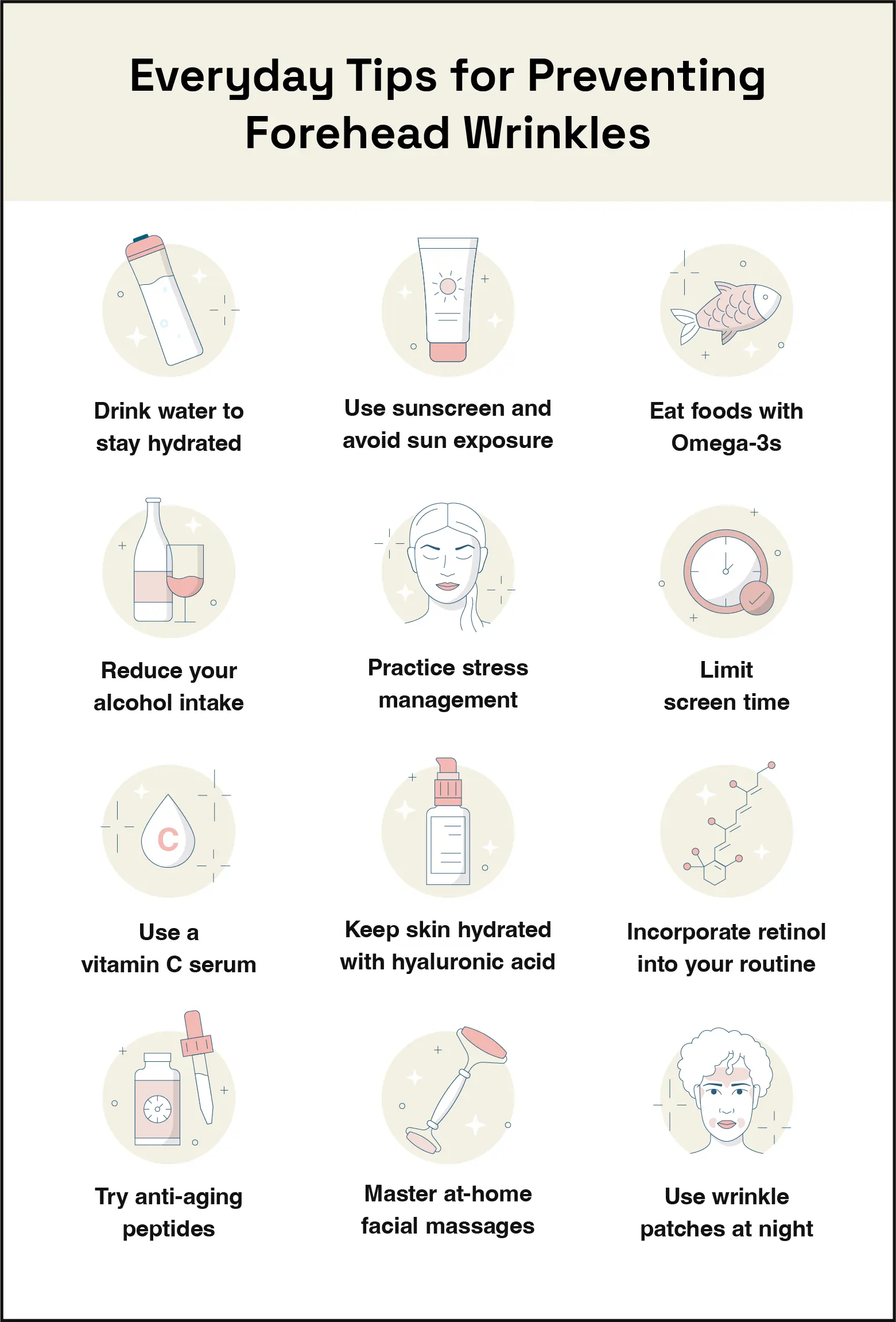
2. Invest in a quality sunscreen
Any esthetician will agree that the most important anti-aging skin care product is an excellent sunscreen. Prolonged exposure to the sun and UV light has numerous long-term effects on the skin, such as dark spots, fine lines, and wrinkles — what dermatologists refer to as photoaging.
According to multiple studies, sunlight and UV radiation are responsible for nearly 80 percent of visible signs of aging. Luckily, photoaging is a type of exogenous aging, meaning it’s caused by environmental factors we have some control over — and that control comes in the form of sunscreen, hats, and sunglasses.
The best facial sunscreen for your skin may depend on skin type and personal preference, but skin care experts recommend a daily full-spectrum product with SPF 30 or higher, regardless of skin type or tone.
3. Incorporate omega-3s into your diet
Foods loaded with omega-3 fatty acids — such as salmon, flaxseed, tofu, and walnuts — can help regulate the skin’s oil production, balance hydration, prevent breakouts, and minimize fine lines and wrinkles. Omega-3s improve the fatty acid composition in your skin and regulate its inflammatory response, keeping skin soft and supple.
While the amount of omega-3s you need for optimal skin health is determined by a number of factors, health experts recommend shooting for 500 mg per day. One easy way to do this is by taking a fish oil supplement along with your daily vitamins.
4. Reduce sun exposure
If you’re the type who likes to lie by the pool and soak in the sun, you might want to reconsider. Even with a high-SPF sunscreen, it’s important to limit the amount of direct sunlight you receive to prevent forehead wrinkles and other signs of aging, especially between 10 a.m. and 3 p.m. when rays are strongest.
While a sun-kissed glow may give the impression of self-care and health, any sun tan equals skin damage. Skip the tanning oil and opt for self-tanner or spray tans instead.
5. Avoid alcohol
It’s alright to enjoy a glass of wine or celebrate with a frosty margarita now and then, but excessive alcohol — more than one drink a day for women, or two for men — isn’t great for your overall health, including your complexion.
As your metabolism breaks down alcohol, a byproduct called acetaldehyde is released into the body. Acetaldehyde is toxic to body tissue and skin, which is why your skin can often look dull and parched after a binge. Repeating this cycle too often can result in routinely dehydrated skin that lacks the firmness and elasticity needed to keep forehead wrinkles at bay. Alcohol can also affect your sleep cycle, which compromises your body’s cellular turnover that aids in skin regeneration.
6. Practice stress management
Stress isn’t just emotionally draining — it can have physical implications as well. In addition to repeated furrowing of your brows, chronic stress can raise your blood sugar and in turn decrease collagen production and reduce your skin’s elasticity.
When you begin to feel overwhelmed, it’s good practice to have a stress management plan in place to keep your mind and skin in tip-top shape. Try taking a walk, practicing yoga, meditating, reading a book, or treating yourself to an at-home facial next time you’re feeling stressed out.
7. Limit screen time
You may want to think twice the next time you decide to binge the new season of your favorite TV show. Research shows even just 60 minutes of daily blue light exposure emitted from electronic devices like TVs, smartphones, or computers can trigger changes in your skin, including cell shrinkage and premature wrinkles.
One obvious way to avoid skin damage caused by blue light is to cut back on screen time, but that’s easier said than done for people who rely on computers to do their job. Luckily, protecting your skin can be as simple as switching your display settings to “night mode” as you work or investing in blue light filters for your screens.
8. Use a daily vitamin C serum
Vitamin C serums have been touted as some of the best anti-aging skin care products on the market, and for good reason. Incorporating this all-in-one miracle ingredient into your routine can help:
- Keep your skin hydrated
- Brighten your complexion
- Reduce under-eye circles
- Prevent sagging
- Protect against photoaging
- Reduce redness
- Fade hyperpigmentation
In regard to reducing the appearance of forehead wrinkles, vitamin C has been shown to boost collagen production, which is tied to skin elasticity and firmness. This means investing in a good vitamin C serum may help tighten sagging skin, making your face look firmer and more toned.
You can also get your daily dose of vitamin C by consuming foods with high levels of it, like oranges, red peppers, and spinach. Research suggests a higher intake of vitamin C leads to better skin appearance and a notable decrease in wrinkles.
9. Load up on hyaluronic acid
Similar to vitamin C, products containing hyaluronic acid can improve the elasticity of your skin and reduce forehead wrinkles and lines. Found in everything from cleansers to balms, hyaluronic acid provides a boost of hydration to tired, wrinkle-prone skin.
Your body contains its own stores of hyaluronic acid, but they can be depleted with age or environmental factors like pollution and smoking. Topical products with this active ingredient can help replenish your skin’s hyaluronic acid content, keeping it hydrated and healthy.
10. Work your way up to prescription-grade retinol
Retinol and its prescription-backed counterpart, tretinoin, are both vitamin A derivatives that can help smooth and prevent forehead wrinkles, unclog pores, and exfoliate your skin. These powerful topicals come in many forms, including creams, gels, and serums, and many levels of concentration. You’ll likely need to start with a low-concentration over-the-counter retinol product before asking your dermatologist for prescription-strength retinol, but many skin care experts claim the results are second to none.
Retinoids improve the appearance of fine lines and wrinkles by reducing the breakdown of collagen, making your skin retain its elasticity for longer. However, retinol also makes your skin more sensitive to sunlight, so it’s essential you follow up with a daily SPF 30+ sunscreen.
Retinol and tretinoin are likely to cause some irritation at first, so pay special attention to how your skin reacts to these treatments before upping your dose.
“We recommend easing into prescription-grade retinoids by starting the topical every two to three nights and working up to nightly use,” advises Jessica Cuellar, a board-certified physician associate at San Diego’s Laser Cliniqúe. “In addition, a moisturizer in combination with the retinol may be used to curb some of the dryness and peeling experienced during the purging phase. Lastly, a little goes a long way. Apply a pea-sized amount of product working from outside the face to the middle.”
If irritation continues, you might want to try alternative anti-aging products like peptides or vitamin C.
11. Boost collagen production with peptides
Peptides are one of the newest active ingredients to make their way into cutting-edge skin care. These short amino acid chains link together to form proteins — called polypeptides — that are responsible for virtually every cell function, including collagen production. Peptides can penetrate the top layer of skin and rejuvenate it from the outside in.
There are multiple types of skin-repairing peptides, each with its own unique efficacy and function. The most popular types include:
- Pentapeptides: Also referred to as Matrixyl, or palmitoyl pentapeptide-3, pentapeptides have been shown to stimulate collagen production.
- Hexapeptides: Known to produce a subtle, Botox-like effect by inhibiting neurotransmitters that keep facial muscles from moving, this peptide (Argireline, or acetyl hexapeptide-3) diminishes the creasing that causes fine lines.
- Palmitoyl oligopeptide: This peptide promotes collagen and hyaluronic acid production in the skin to support the skin barrier and protect from photoaging.
- Palmitoyl tetrapeptide-7: Suitable for sensitive skin, this peptide soothes inflammation and stimulates cell regeneration.
- Copper peptides: These peptides are used to enhance skin regeneration, skin elasticity, and firmness.
Unlike retinol, peptides are generally safe for sensitive skin and will not make your skin more susceptible to sun damage. You’ll also see the anti-aging results from peptides faster than retinol, which could take a few weeks to appear.
12. Smooth fine lines with an at-home toning device
Like foam rollers for your face, ancient beauty tools like jade rollers and Gua Sha stones have become commonplace in modern skin care. These toning devices are said to have a slew of wrinkle-busting benefits, including:
- Relieving muscle tension
- Alleviating muscle pain
- Increasing circulation
- Firming skin
- Brightening complexion
- Reducing facial bloating or puffiness
The effectiveness of these tools lies in their ability to help with lymphatic drainage. The lymphatic system is a network of vessels that carry lymph, an infection-fighting fluid, throughout the body to help get rid of excess water, toxins, and other undesired materials. Studies suggest lymphatic massages may facilitate the removal of toxic buildup beneath your skin, which can help reduce the appearance of fine lines and wrinkles.
13. Consider wrinkle patches as a Botox alternative
Frownies and other types of wrinkle patches fight fine lines while you sleep. These products hold skin taut for hours at a time, relaxing deep wrinkles and preventing new ones from forming. After several months, dedicated users claim they were able to retrain their facial muscles to contract less, release tension, and lie flat.
Wrinkle patches won’t magically get rid of age-related wrinkles, but, like Botox, they can help relax areas where tension is clearly visible, like between or above your eyebrows. Some patches even contain hydrating ingredients to plump the skin while you wear them.
It’s important to note that wrinkle patches are relatively new to the skin care market and extensive studies haven’t been done to prove their effectiveness.
“I always tell my patients these products are not harmful, but we also do not have the science and studies proving they work,” claims Cuellar. “Therefore, if you feel like they are working, continue using them.”
Top Professional Treatments for Wrinkles
| Treatment | Average Cost | Consistency |
|---|---|---|
| Facials | $50-$100 | 4-6 weeks |
| Botox | $250-$600 | 3-4 months |
| Laser Treatments | $1,000-$3,500 | 4-8 treatments one month apart |
14. Beat ‘em with Botox
If you’re looking to prevent or reduce your forehead wrinkles fast, Botox may be a good bet.
“Botox is a type of neuromodulator which works to relax the muscle by temporarily disrupting communication between our nerves and muscle actions,” Cuellar explains. “Botox can be used to prevent new or worsening wrinkles and soften the appearance of deep wrinkles.”
You’ll begin to see the results of your Botox injections typically one to three days after treatment, and results can last between three and four months. However, you’ll have to schedule follow-up treatments with your esthetician in order to maintain the effect. Be sure to consult with a trusted skin care expert to determine if Botox treatments are right for you.
15. Schedule a professional facial treatment
Give your skin a refresh during your next spa day with an anti-aging facial treatment. These include:
- Microneedling: a facial rejuvenation procedure that uses tiny needles to poke the skin and cause new collagen and elastin to form as it heals
- Microdermabrasion: A procedure that gently sands your skin to reveal a smoother, brighter, and more even complexion
- Chemical peel: a procedure that uses a chemical solution to remove the top layer of skin, making way for smoother skin as it heals
- Exfoliation: a type of facial that removes dead skin cells from the top layer of skin to brighten your complexion and soften fine lines
- Hydration: a pain-free treatment that infuses skin with a boost of hydrating serums and moisturizers.
- Microcurrent facial: a popular noninvasive facial that tightens skin by stimulating the facial muscles with tiny electrical currents.
If you want to supplement your skin care routine with regular facials, double-check with your esthetician to see how often you’ll need to schedule a facial to keep your skin looking youthful.
16. Tighten skin with a professional laser treatment
No matter your skin concern, there’s likely a laser treatment for it, and that includes forehead wrinkles. Using advanced energy-based technology, treatments like laser skin resurfacing help exfoliate skin and penetrate the subdermal layers to promote the body’s natural regenerative processes. That means results aren’t just surface-level — they’re literally skin-deep.
Laser treatments are also used to address concerns like:
- Blemishes and dark spots
- Acne and acne scars
- Sun damage
- Uneven pigmentation
- Uneven skin texture
Depending on the type of laser system your dermatologist recommends and how your skin responds to the treatment, laser procedures can help minimize fine lines and forehead wrinkles in as little as two treatments.
17. Talk to an esthetician for a personalized approach
When it comes to preserving your skin health, don’t let influencers, magazine ads, or your mother-in-law decide what’s best for you. Aging can be daunting, but a certified esthetician or licensed dermatologist can help create a customized plan to nix forehead wrinkles and maintain a youthful complexion. Find a local esthetician for professional wrinkle-busting recommendations.
What causes forehead wrinkles?
There are two types of factors that contribute to fine lines and wrinkles: endogenous and exogenous. Endogenous factors, such as age, hormones, and genetics, take place on the inside of your body, while exogenous factors, like sun exposure and pollutants, are a product of our environment.
While aging is a natural process, it’s a combination of both endogenous and exogenous factors that may be causing your wrinkles to appear. We don’t have much control over most of our internal workings, but we have the power to influence some external factors to curb signs of aging. In order to find an anti-aging treatment that’s right for you, it’s important to understand how the following elements may be affecting your skin health.
- Overuse of forehead muscles: Contracting the frontalis muscle — the muscle used to raise or furrow your brows — will inevitably cause worry lines to form over time. However, stress, visual fatigue, or excess skin on the eyelid may lead you to overwork this muscle and create premature wrinkles.
- Aging: As we age, our skin decreases natural oil, collagen, and elastin production needed to maintain its elasticity and plumpness. The result is loose, saggy skin, fine lines, and wrinkles. As scary as that sounds, aging is inevitable and completely unavoidable (unless you’re JLo). Accept that you can’t magically reverse signs of aging, but there are steps you can take to delay them.
- Excess sun exposure: One of the best ways to prevent forehead wrinkles is by applying an SPF 30+ sunscreen daily and limiting sun exposure. Harsh UV rays can damage the DNA in skin cells, leading to premature aging.
- Smoking and drinking: Alcohol and cigarettes contain toxins that can dry out your skin and inhibit cellular turnover. Consistent water loss will cause your skin to contract, forming deep wrinkles over time.
- Genetics: In some cases, you can thank your parents for your forehead wrinkles. Your genetic makeup not only determines your skin tone, but also the amount of collagen and elastin your skin cells produce — which work to keep skin plump and hydrated.
Forehead Wrinkle FAQs
Forehead wrinkles do not go away, but there are steps you can take to reduce the appearance of them, such as keeping your skin hydrated or opting for a muscle-relaxing injection like Botox.
Once forehead wrinkles set in, it may be impossible to totally get rid of them. However, some ways to naturally reduce the appearance of wrinkles are:
● Using natural anti-aging skin care products
● Applying a high-quality SPF 30+ daily sunscreen
● Trying at-home or professional facial massages and lymphatic drainage
● Reducing stress
● Eating foods rich in omega-3s
● Staying hydrated
● Avoiding smoking and limiting alcohol intake
The age when forehead wrinkles start to form depends entirely on your genetics, lifestyle, health, and environment. Generally, you’ll want to start incorporating anti-aging products into your skin care routine as early as your 20s, and you should be using a daily SPF 30+ sunscreen no matter your age to keep your skin vibrant.
Staying hydrated can prolong the appearance of youthful skin, but once fine lines and wrinkles set in, there’s no amount of water that can reverse them.
Forehead wrinkles and frown lines are a natural part of the aging process, but so is recognizing that the self-care routine you practiced in your 20s might not be doing your complexion any favors now. The earlier you adapt your diet, water intake, and skin care routine to cater to the prevention of fine lines and wrinkles, the longer you’ll be able to maintain a smooth complexion.
If fighting your forehead wrinkles feels like an uphill battle, talk to an esthetician or dermatologist to learn which anti-aging products or treatments will work best for your skin.
